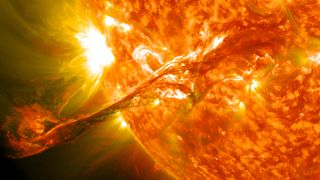It has been a busy time for solar activity. Back in March of 2022, Earth was hit by separate geomagnetic storms, according to government weather agencies in the U.S. and the U.K.
Though the geomagnetic storms likely didn't cause any harm, they brought into focus the potential harm that could come from more powerful storms in the future.
Then earlier this month, a G1-class geomagnetic storm hit the Earth, causing bright auroras over Canada. The only problem is that nobody saw this storm coming until it was quite late.
Five days ago, a giant sunspot and filaments on the solar surface had astronomers worried about possible Earth-directed solar flares and coronal mass ejections (CMEs) that could lead to blackouts.
Finally, on Friday, it was reported that a massive solar flare had erupted from the Sun, which could see radio blackouts in many parts of the world.
A "direct hit" from a solar storm
Now, on Saturday, Dr. Tamitha Skov, known as the "Space Weather Woman," predicted a "direct hit" from a solar storm to take place on Tuesday. She took to social media to share the news along with a NASA prediction model video.
Skov is a research scientist at the federally funded Aerospace Corporation and an award-winning science educator on social media.
"Direct Hit!" she wrote on Twitter. "A snake-like filament launched as a big solar storm while in the Earth-strike zone."
"NASA predicts impact early July 19. Strong Aurora shows possible with this one, deep into mid-latitudes," she explained, adding that there could be disruption to GPS and amateur radio. READ MORE...
A solar storm, or coronal mass ejection (CME), erupts from the sun in August 2012. (Image credit: NASA Goddard)
The sun is always showering Earth with a mist of magnetized particles known as solar wind. For the most part, our planet's magnetic shield blocks this electric wind from doing any real damage to Earth or its inhabitants, instead sending those particles skittering toward the poles and leaving behind a pleasant aurora in their wake.
But sometimes, every century or so, that wind escalates into a full-blown solar storm — and, as new research presented at the SIGCOMM 2021 data communication conference warns, the results of such extreme space weather could be catastrophic to our modern way of life.
In short, a severe solar storm could plunge the world into an "internet apocalypse" that keeps large swaths of society offline for weeks or months at a time, Sangeetha Abdu Jyothi, an assistant professor at the University of California, Irvine, wrote in the new research paper. (The paper has yet to appear in a peer-reviewed journal).
"What really got me thinking about this is that with the pandemic we saw how unprepared the world was. There was no protocol to deal with it effectively, and it's the same with internet resilience," Abdu Jyothi told WIRED. "Our infrastructure is not prepared for a large-scale solar event."
Part of the problem is that extreme solar storms (also called coronal mass ejections) are relatively rare; scientists estimate the probability of an extreme space weather directly impacting Earth to be between 1.6% to 12% per decade, according to Abdu Jyothi's paper.
In recent history, only two such storms have been recorded — one in 1859 and the other in 1921. The earlier incident, known as the Carrington Event, created such a severe geomagnetic disturbance on Earth that telegraph wires burst into flame, and auroras — usually only visible near the planet's poles — were spotted near equatorial Colombia. Smaller storms can also pack a punch; one in March 1989 blacked out the entire Canadian province of Quebec for nine hours. READ MIRE
A massive Internet outage can be caused by a massive solar storm today. The Indian scientist says global infrastructure is very vulnerable to, what she called, solar superstorms. Therefore, the world must prepare itself for a destructive solar storm that can knock out the Internet across the world.
A solar storm has a massive potential for destruction, especially when it comes to electronics and infrastructure. So, any big enough solar storm today, would have a catastrophic impact on the global infrastructure that keeps our Internet running. However, if the digital infra is destroyed, it will bring the Internet down along with it. An Internet outage in this modern era will not only cause massive money loss, it would also cost many lives.
The Internet is the backbone of everything that happens in the world today, but nothing carries a greater threat of a mass outage than solar storms. A big enough solar storm today, referred to as a 'solar superstorm', can threaten this very backbone. The world, as such, in unprepared for a solar storm-Internet linked apocalypse. This is in addition to having an impact on the electrical grids, which has already been documented in the case of past solar storms that were truly massive in nature.
Solar storm and the Internet: Sangeetha Abdu Jyothi starts her research paper with this sentence, "Black swan events are hard-to-predict rare events that can significantly alter the course of our lives. The Internet has played a key role in helping us deal with the coronavirus pandemic, a recent black swan event.
However, Internet researchers and operators are mostly blind to another black swan event that poses a direct threat to Internet infrastructure. We investigate the impact of solar superstorms that can potentially cause large-scale Internet outages covering the entire globe." READ MORE


